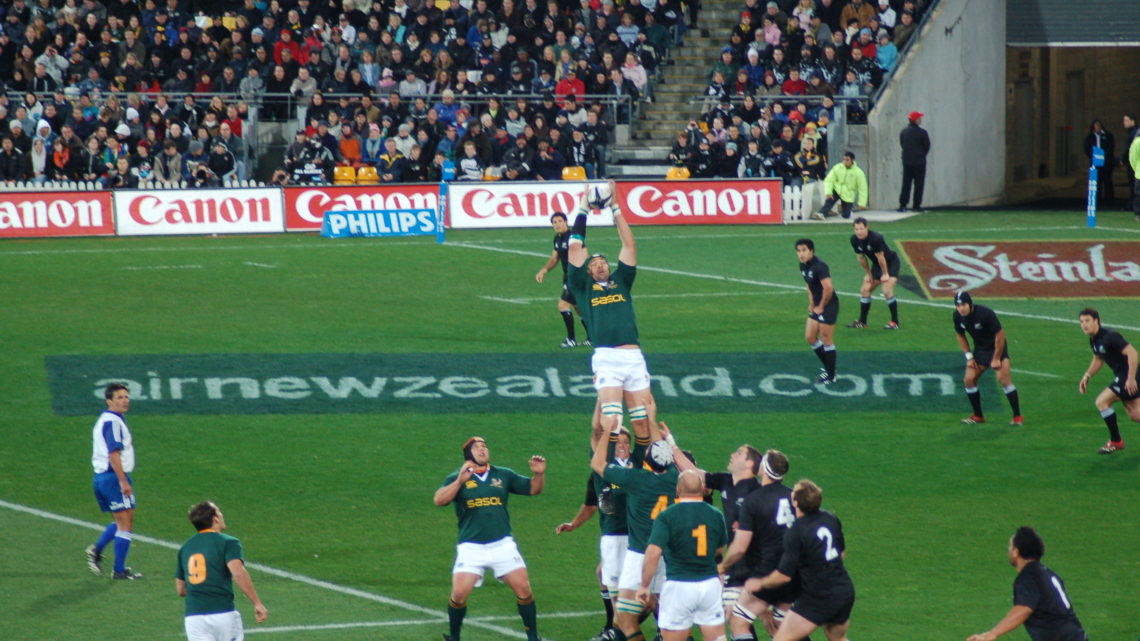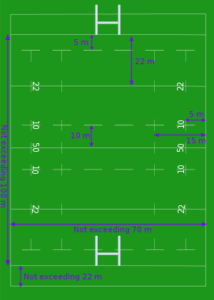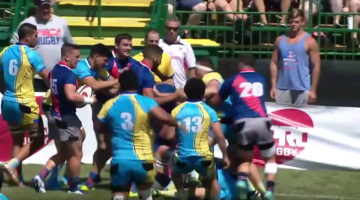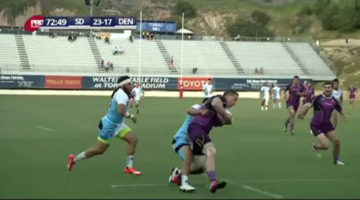Let’s try and break down the basics of the game of rugby into a language the new fan can understand. I mentioned in my first beginners guide that rugby is kind of like NFL, but with NHL rules, in simple terms: if you don’t have the ball, kill the guy with the ball. If you do have the ball, run!
In all seriousness though, rugby at its heart is a study of paradoxes. It is phenomenally simple in that the ultimate goal is to move the ball from your defensive end of the field through the opposition half and score a try. At the same time it is also an incredibly complex game of skill, patience and strategy, requiring careful planning of set piece plays which require precision timing. It may look like a wild, untamed melee, in fact more often than not what you’re witnessing is a passage of play that these teams have been practicing for weeks on end.
Let’s run through some of the basics to get this course of learning underway.
Teams:
Each rugby team is made up of 22 players, 15 who take the field for the start of the game, and up to seven reserves. The players ostensibly have set roles and positions that they play, wingers for example tend to be on the outside edges of the field, and tend to be leaner than most, built for fast breaks and the ability to cover the field with explosive acceleration, we’ll go into more of the positional details later though. While the players have set roles and positions these tend to be fairly fluid for some players, who will happily engage on multiple platforms during the passage of the game.
Game Length:
Each game is played in two halves of 40 minutes each, with a ten minute break at halftime. Unlike Association Football (Soccer) there is no injury time as such, if the game needs to be stopped for a serious injury the referee stops the clock at the time of the incident, otherwise clock stoppages are usually fairly rare.
This does of course mean teams can use tactical play late in the half to run the clock out (much like taking a knee during the two minute warning) and while it may slow the game down it can lead to risks if the opposition gets the ball in the dying seconds of the half.
The reason this is so risky is unlike NFL, if a play is underway at the end of the half, while the time may have elapsed the play is still considered in motion, and will be allowed to continue until either the play is completed and the team in possession of the ball scores a try, or the opposition team gets the ball and kicks it out of the field of play. It is therefore theoretically possible that a team can win a game in the 82nd minute of a game. Actually I shouldn’t say theoretical, I’ve seen it happen many times. The benefit here though is that the game is allowed to finish based on plays, not the clock, so upset wins are certainly a possibility.
Scoring:
We’ll go into more detail about this in future articles, however the basics of scoring in rugby are:
Try (equivalent to a touchdown) – 5 points
Conversion – 2 Points
Penalty Goal – 3 Points
Drop Goal – 3 Points
Penalty goals are awarded when the teams kicker (usually the player in the number 10 jersey) kicks the ball through the goalposts at the end of the field, going over the crossbar and between the posts, much like a conversion. Drop goals are the same thing, but occur during a passage of play rather than as the result of an infringement.
The Field:
The hallowed ground, the place of battle, the land where legacies are created, where heroes rise and where nations are brought to a standstill. A rugby field, like a football field, is a place that is more than just a patch of dirt where the players run around. Names like Twickenham, Landsdowne Road, and Eden Park are intoned in similarly hushed and reverential tones as Foxboro stadium or Fenway park.
The actual mechanics of the field are the same around the world:
The field itself is 100 meters long, with a total playing space of 112 – 122 meters by 68 meters (122.5-133.4 × 74.3 yards) including in goal area
The sidelines are called touchlines
Other important lines on the field include the halfway mark at 50-metres.
A dashed 10-metre line set each side of the 50-metre-line, which is used to judge kick-offs, and a solid 22-metre line marked 22-metres from each tryline.
Other lines include two dashed lines set at 5 and 15-metres marked parallel to each touchline. These lines are used mostly to identify the zones for lineouts.
Again this is more a broad strokes overview of the field of play, we’ll come back to this in later articles when we look at what impact being in certain parts of the field has to game play
Passages of play – How to begin.
Before the game commences, both captains meet and toss a coin (sometimes a ceremonial medallion, as was the case in the Rugby World Cup, often though an actual physical coin) to decide who will kick off for the first half, and which direction the teams will run in for the first half. Generally if team A wins the toss, they will decide who is kicking off, and team B will decide the direction of play for the first half.
Once this is established the teams take the field, and the kicking team will begin the game on the referees whistle by kicking the ball into the opposition half. While teams vary in the depth that they kick, the ball must travel a minimum of ten meters for the kick-off to be legal, otherwise a penalty is awarded to the opposition team.
If the kick-off is successful, the opposition team (assuming they have maintained possession of the ball) begin the process of trying to move the ball up the field of play to cross the try line at the opposite end of the field and score five points.
This covers off the basic basics of rugby gameplay, in the next issue of The (Sort Of) Beginners Guide to Rugby we’ll delve a bit deeper into the players themselves, the positions they play and their impact on the game. If you have any specific questions you’d like me to cover drop me a message on twitter or email me kylewilloughby.rugby@gmail.com
Kyle Willoughby is a New Zealand based rugby writer, Boston Sports fan and former media manager for the Tongan Rugby Union operating internationally to share rugby news from the USA around the world. Follow Kyle’s Twitter feed for more rugby and sports tweets.





